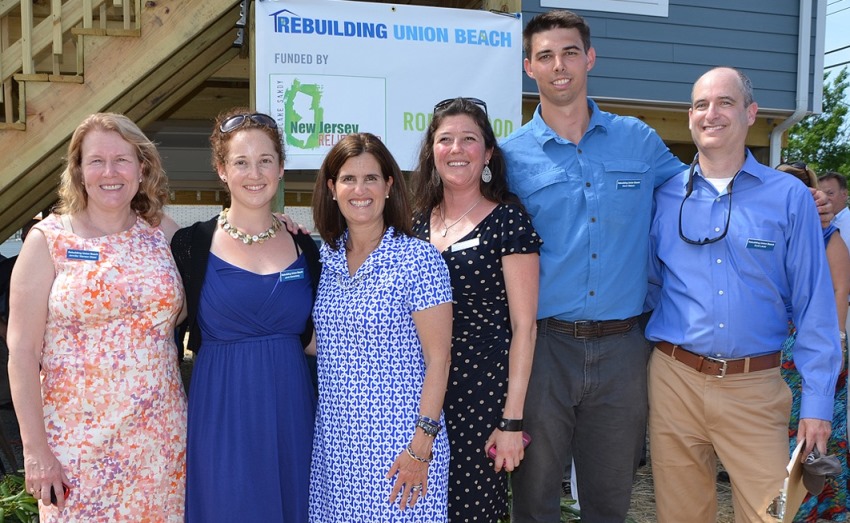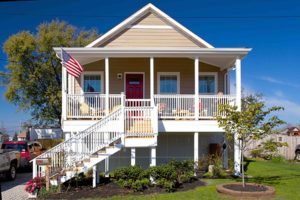The morning after Hurricane Sandy struck New Jersey, the Union Beach Borough Hall was filled with residents standing shoulder-to-shoulder.
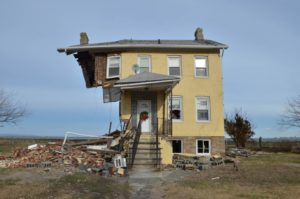 They were cold, hungry and homeless. Our normal 9-to-5 became 12-hour days, 7 days a week. The phone never stopped ringing, and there were long lines of people waiting at the Borough Administrator’s office door; hopeless and in tears. Overnight, our small town became a rapid response hub for the entire Raritan Bayshore area.
They were cold, hungry and homeless. Our normal 9-to-5 became 12-hour days, 7 days a week. The phone never stopped ringing, and there were long lines of people waiting at the Borough Administrator’s office door; hopeless and in tears. Overnight, our small town became a rapid response hub for the entire Raritan Bayshore area.
Union Beach is a small, low-to-moderate-income community located on the Raritan Bay in New Jersey. More than a third of the residences were built as single-story summer bungalows in the early 1900s. Union Beach is a tight-knit, multi-generational community, and many families live paycheck to paycheck.
Union Beach accepted help from organizations and volunteers from around the country. The Borough Hall Senior Center was transformed into a resource center providing everything from food and clothing to mold remediation and demolition services. After the initial shock of the enormity of the devastation, we saw the opportunity to build a sustainable and cost-effective housing solution for the community. The result is Rebuilding Union Beach, a modular home demonstration and green infrastructure project.
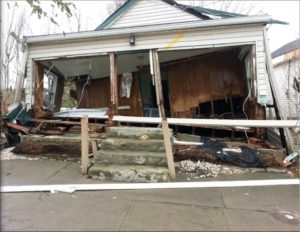 Rebuilding Union Beach designed and built 14 homes for families whose homes were destroyed by Hurricane Sandy. The primary goal was to build back better by creating an affordable model home that was both storm-resilient and sustainable. The project has proven the potential of modular construction to provide permanent post-storm housing at scale to help communities rebuild and recover in the aftermath of a natural disaster. Rebuilding Union Beach maximized funds from government programs, insurance proceeds, and other recovery funds.
Rebuilding Union Beach designed and built 14 homes for families whose homes were destroyed by Hurricane Sandy. The primary goal was to build back better by creating an affordable model home that was both storm-resilient and sustainable. The project has proven the potential of modular construction to provide permanent post-storm housing at scale to help communities rebuild and recover in the aftermath of a natural disaster. Rebuilding Union Beach maximized funds from government programs, insurance proceeds, and other recovery funds.
Sites are now graded to slope away from the high spot below the home. Permeable driveway materials and simple rain garden concepts help reduce storm water, erosion, and flooding. These include collecting storm water in bioswales and rain gardens that have plants set in layers of stone to hold and absorb water. Rain barrels are used to collect water from the roof to reduce runoff, provide a usable resource, and conserve water and reduce water bills.
Strategic planting of trees, shrubs and plants may help make homes more resilient and sustainable while reducing utility bills. Planting may be used to provide shade, mitigate winds, slow and absorb onsite water, promote soil retention, create privacy and promote a healthy eco-system. Rebuilding Union Beach used native, non-invasive plants. Generally, these resist damage from freezing, drought and common diseases, produce long root systems to hold soil in place and require less water and maintenance.
Rebuilding Union Beach developed a Project Guide to inform the rebuilding efforts of other shore towns affected by Hurricane Sandy. The Guide describes how we built high-quality, resilient, and cost-effective housing that enhanced our community; it also reveals what we learned in the process. Both modular construction and traditional on-site construction were used in our project, and their respective benefits and challenges are documented in this guide.
The post-storm construction boom in New Jersey caused increased costs for labor and materials, due to a lack of available and experienced labor and shortages in supplies, making on-site construction difficult in terms of both logistics and expenses. The homes constructed on-site were more costly and prone to extended delays, and construction quality issues which were further compounded by inclement weather. 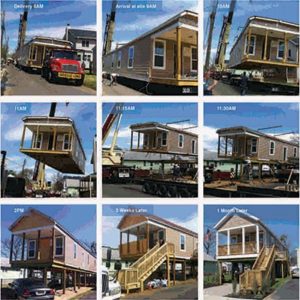
Modular home construction was chosen for the majority of homes because it offered a potentially faster and more cost-effective way to rebuild than traditional on-site construction. Modular homes are built to the same code standards as a home built on-site. This differentiates them from manufactured or mobile homes.
Modular construction was slightly faster and more cost-effective with a lower price per square foot. However, the savings were somewhat offset by expensive truck delivery costs and local crane operations. Still, the modular homes were ultimately built faster, cost less, had environmental benefits, and had fewer issues than those homes built on-site.
Thoughtful site-planning and design has helped make Rebuilding Union Beach homes more sustainable and resilient. New municipal codes were instituted after the storm to minimize street parking in order to keep streets clear for emergency and public works vehicles. Driveways were incorporated into site layouts. Revised site setbacks and other rules developed by the municipality re-defined the distance from the property line to the home in order to meet fire code, as well as minimum grading and landscaping.
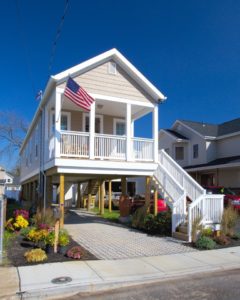 Carefully considered layouts of driveways, sidewalks, stairways, lifts, porches, landscaping, and mailboxes help create a welcoming appearance. Elevating homes on piles exposes the area underneath, which can be a design challenge in shore communities. Homeowners used these areas for various activities including parking, shaded seating, and recreation. They became attractive assets when combined with planting, trellis screening, lighting under the home, and the use of light colored paint on the underside of the home to reflect light.
Carefully considered layouts of driveways, sidewalks, stairways, lifts, porches, landscaping, and mailboxes help create a welcoming appearance. Elevating homes on piles exposes the area underneath, which can be a design challenge in shore communities. Homeowners used these areas for various activities including parking, shaded seating, and recreation. They became attractive assets when combined with planting, trellis screening, lighting under the home, and the use of light colored paint on the underside of the home to reflect light.
Many builders and modular manufacturers offer design services, however, these are not necessarily provided by qualified staff. We engaged licensed professionals to ensure homes are designed to satisfy homeowners’ needs, budgets, and site conditions.
- Home models were matched to home owners based on their family size, lot size, and special needs;
- Front porches were installed at each home to extend the living space, increase security on the street, and provide an opportunity to be outdoors and connect with neighbors. This is particularly important for elderly and disabled residents;
- Layouts are efficiently designed to maximize usable space;
- A palette of light colors was offered to homeowners to match the bayside location, reflect light, and provide options with broad appeal;
- Tall windows are used extensively to maximize natural light and views;
- Proportions and materials were carefully considered to create a beautiful home, minimize maintenance in a coastal climate, and create an attractive streetscape;
- Stair rails should be easily graspable to avoid the need for a separate guardrail and handrail. These are readily available for interior use but may need to be ordered in advance for exterior use where pressure-treated wood is required;
- Donations of furniture, kitchen and cleaning itemsand linens were provided in order for families who lost their belongings to use their homes immediately upon move-in. Donations of porch furniture, mailboxes and American flags provided a welcoming touch.
Solar panel systems were provided to give homeowners more independence from increasing utility rates and generates income to offset property tax increases. This contributes to the homeowner’s long-term financial stability and provides ecological benefits. In addition, should electrical power be lost, solar can provide some power in the home and if gas services are not damaged, there is a reduced likelihood of the resident needing temporary housing.
The aftermath of Hurricane Katrina and Hurricane Sandy has shown the challenges of implementing effective post-storm housing solutions. A clear vision from the outset is critical, as are realistic funding expectations, staff members with the right skillsets, and organization partners to provide critical support services.
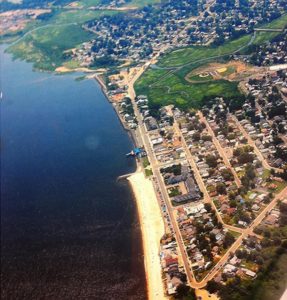 The shifting landscape of post-storm funding and housing assistance was the first planning hurdle we faced. FEMA reimbursement rules and flood mapping fluctuated for months, and New Jersey’s Reconstruction Program (RREM) changed substantially over time. The lack of certainty made it difficult to design a strong program that would best leverage resources. In response, Rebuilding Union Beach evolved into a demonstration project for families both with and without insurance proceeds or other resources. The average grant issued by rebuilding Union Beach is similar to that offered by RREM.
The shifting landscape of post-storm funding and housing assistance was the first planning hurdle we faced. FEMA reimbursement rules and flood mapping fluctuated for months, and New Jersey’s Reconstruction Program (RREM) changed substantially over time. The lack of certainty made it difficult to design a strong program that would best leverage resources. In response, Rebuilding Union Beach evolved into a demonstration project for families both with and without insurance proceeds or other resources. The average grant issued by rebuilding Union Beach is similar to that offered by RREM.
Our team spent a significant amount of time and effort addressing the social, medical, and financial issues of participating families. After losing their homes, many families had to pay for temporary accommodations in addition to the existing mortgage and taxes on the homes they lost in the storm. We worked with case managers from partner organizations to help families navigate the labyrinth of insurance claims, grant assistance programs, and other regulations and requirements. This support helped families focus on rebuilding and financial planning to avoid foreclosures and other complications.
We also spent considerable time looking for ways to leverage available funding and pro-bono resources. Rebuilding Union Beach worked with architects and many wonderful partners to build the most resilient, sustainable, cost-effective, and beautiful homes possible. We are gratified that 14 families have returned home and that other regional housing providers have developed their own programs based on this model.
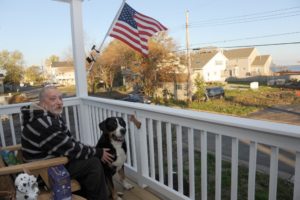 “After the initial shock of the devastation from Hurricane Sandy I saw the opportunity to develop a resilient, cost-effective, and sustainable housing solution for our community,” said Jennifer Maier, founder of Rebuilding Union Beach and former Borough Administrator of Union Beach. “We hope that in sharing our experience completing this project we can inform and encourage the implementation of similar post-storm housing models that have the ability to shape stronger and better prepared communities.”
“After the initial shock of the devastation from Hurricane Sandy I saw the opportunity to develop a resilient, cost-effective, and sustainable housing solution for our community,” said Jennifer Maier, founder of Rebuilding Union Beach and former Borough Administrator of Union Beach. “We hope that in sharing our experience completing this project we can inform and encourage the implementation of similar post-storm housing models that have the ability to shape stronger and better prepared communities.”
Rebuilding Union Beach has received awards from the American Planning Association NJ Chapter, Plansmart NJ, NJ Hero, and a NJ State Senate and General Assembly Resolution in recognition of its resilient, cost-effective and sustainably designed homes.
The Rebuilding Union Beach Team comprises: Jennifer Maier, Founder; Scott Lauer; Jovia Nierenberg; Kevin Watson; and Brenda Zimmerman.
About The Author:
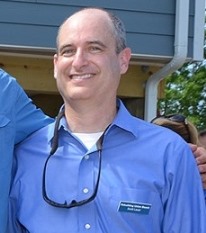 Scott Lauer is an architect and capital projects executive with extensive design, construction and non-profit experience.
Scott Lauer is an architect and capital projects executive with extensive design, construction and non-profit experience.
He is currently working with the NYC Housing Recovery Office to develop a modular home program to rehouse storm-affected families.
Scott also founded Open House New York which runs design-education programs including America’s largest architecture and design event, OHNY Weekend.

